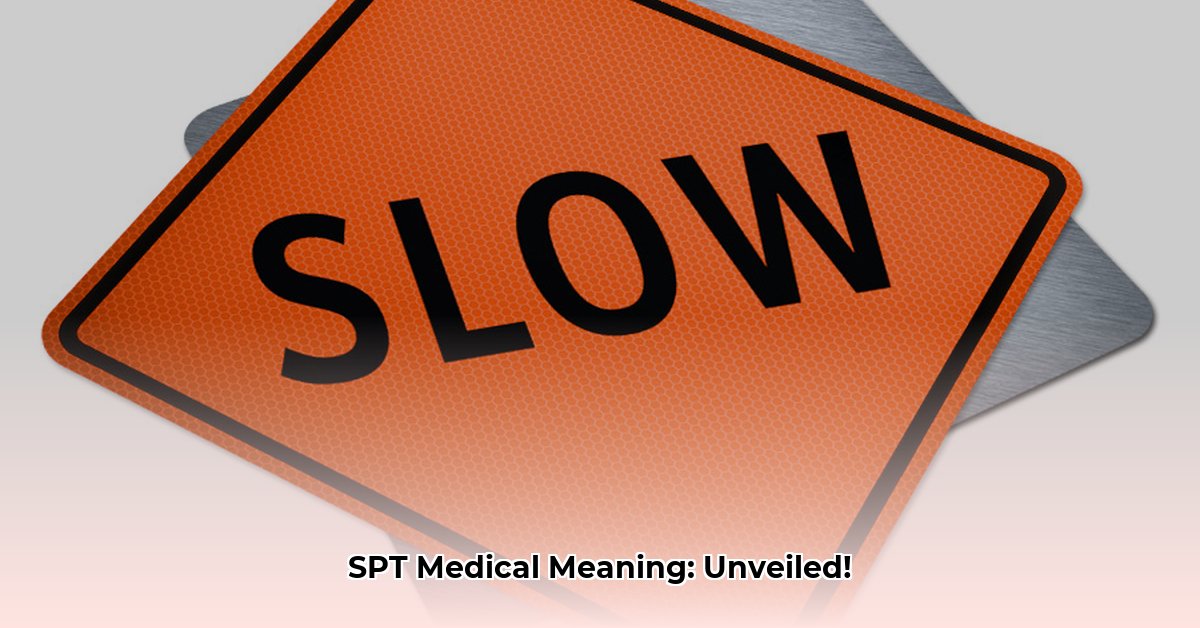SPT: three little letters that can mean a lot of different things in the medical world. This guide deciphers the various meanings of SPT, providing clear explanations and addressing potential confusion so you can confidently understand its significance in your medical journey.
Decoding SPT: A Quick Summary
SPT can stand for several medical terms, the most common being Skin Prick Test, Suprapubic Tube/Catheter, and Second Primary Tumor. The meaning depends entirely on the context. Here’s a quick reference table:
| Abbreviation | Meaning | Medical Field(s) |
|---|---|---|
| SPT | Skin Prick Test | Allergy/Immunology |
| SPT/SPC | Suprapubic Tube/Catheter | Urology |
| SPT | Second Primary Tumor | Oncology |
| SPT | Spinal Tap (less common) | Neurology |
| SPT | Supportive Periodontal Therapy | Dentistry/Periodontics |
| SPT | Solid Pseudopapillary Tumor | Oncology/Pathology |
| SPT | Student Physical Therapist | Physical Therapy (Student role) |
| SPT | Sleep Period Time | Sleep Medicine |
Exploring the Meanings of SPT
Let’s delve deeper into each possible meaning of SPT, providing detailed explanations and relevant information.
1. Skin Prick Test (SPT): Unveiling Allergies
The Skin Prick Test (SPT) is a cornerstone of allergy testing. This simple procedure involves introducing tiny amounts of potential allergens to your skin via a small prick. A raised, itchy bump (wheal) suggests an allergic reaction. The size of the wheal may indicate the severity of the allergy.
- How it works: Allergen extracts are placed on the skin, typically on the forearm or back. A lancet pricks the skin beneath the droplet. Reactions are observed over 15-20 minutes.
- Why it’s used: SPT is effective in identifying IgE-mediated allergic reactions to common allergens like pollen, pet dander, dust mites, and certain foods.
- Considerations: False positives and negatives can occur. Medications, particularly antihistamines, should be discontinued prior to testing to avoid skewed results. Ongoing research continually refines our understanding of allergies and testing methods.
2. Suprapubic Tube/Catheter (SPT/SPC): An Alternative Urinary Pathway
A Suprapubic Tube/Catheter (SPT/SPC, more commonly SPC) offers an alternative way to drain urine when the urethra is blocked or unusable. This thin tube is inserted into the bladder through a small abdominal incision above the pubic bone.
- Why it’s used: SPCs are often necessary for individuals with urethral blockages, urinary retention, certain neurological conditions (e.g. multiple sclerosis, spinal cord injuries, prostate cancer), or after specific surgeries.
- Types and Placement: Insertion is typically guided by ultrasound with local or general anesthesia. A small balloon anchors the catheter within the bladder.
- Care and Considerations: Regular cleaning, emptying the collection bag, and flushing the catheter are crucial. Potential complications include infection, blockages, bladder spasms, and skin irritation.
Comparison of Suprapubic and Foley Catheters:
| Feature | Suprapubic Catheter (SPC) | Foley Catheter |
|---|---|---|
| Insertion Site | Small incision in the abdomen | Through the urethra |
| Comfort Level | Generally more comfortable, greater mobility | Can cause discomfort or irritation |
| Long-term Use | Suitable for long-term use | Typically short-term |
| Infection Risk | Potentially lower | Potentially higher |
| Impact on Intimacy | Less likely to interfere | May impact intimacy |
3. Second Primary Tumor (SPT): A New Cancer Diagnosis
In oncology, SPT signifies a Second Primary Tumor—a new, unrelated cancer in someone with a history of cancer. This is distinct from cancer recurrence or metastasis.
- Distinguishing SPT: An SPT is a separate malignancy with its own distinct characteristics, originating in a different location than the original cancer.
- Ongoing Research: Scientists continuously strive to better understand SPTs, including risk factors, prevention strategies, and optimal treatment approaches.
4. Other Meanings of SPT
While less common, SPT can also represent:
- Spinal Tap (Lumbar Puncture): A procedure to collect cerebrospinal fluid for diagnostic purposes.
- Supportive Periodontal Therapy: Ongoing dental care to maintain gum health after periodontal disease treatment.
- Solid Pseudopapillary Tumor: A rare pancreatic tumor.
- Student Physical Therapist: A student pursuing a Doctor of Physical Therapy degree.
- Sleep Period Time: A term used in sleep studies.
Clarifying the SPT/SPC Confusion
The use of both SPT and SPC for Suprapubic Catheter can be confusing. Always clarify with your healthcare provider which meaning is intended. Open communication is vital for understanding your medical care.
The Importance of Context
Context is crucial when deciphering SPT. Surrounding medical information, such as mentioning allergies, bladder issues, or cancer treatment, will guide you to the correct interpretation. Never hesitate to ask your doctor or nurse for clarification.
Conclusion
While this guide provides comprehensive information, it is not a substitute for professional medical advice. Always consult with a qualified healthcare provider for any health concerns or to discuss your specific medical situation. Medical knowledge is constantly evolving, so staying informed and proactive in your healthcare is essential.
- Wind Power Energy Advantages: Clean, Domestic And Cost-Effective Power - November 12, 2025
- Wind Turbine Pieces: Examining The Industrys Future Growth - November 9, 2025
- Wind Turbine Installation: Building the Future of Energy - November 7, 2025
















